Results 1 to 1 of 1
Thread: XBOX ONE Details In Pictures
-
September 1st, 2013, 22:27 #1Won Hung Lo













- Join Date
- Apr 2003
- Location
- Nottingham, England
- Age
- 52
- Posts
- 139,563
- Blog Entries
- 3209
- Rep Power
- 50
 XBOX ONE Details In Pictures
XBOX ONE Details In Pictures
Microsoft outed some technical details about the XBox One SoC today at Hot Chips 25.
Discuss on our forums here: http://team-xecuter.com/forums/showt...ls-In-Pictures
Microsoft outed some technical details about the XBox One SoC today at Hot Chips 25.
XBox One SoC and some details
Physically, the system-on-a-chip at the heart of the Xbox One is 363 square millimeters. But the real whopper is the amount of logic integrated within it: 5 billion transistors. Although Wikipedia isn’t necessarily the final arbiter, the Xbox One is possibly the largest chip manufactured to date, with a comparable number to Intel’s 64-core Xeon Phi coprocessor for supercomputers, and easily topping Intel’s 8-core “Poulsen” Itanium that the chip maker launched in 2012.
Unfortunately, Microsoft didn’t disclose how much power that chip will consume. However, the chip will be power gated down to 2.5 percent of its power, said John Sell, a hardware architect at Microsoft who gave the Xbox One silicon presentation at Hot Chips. It will be manufactured in 28-nm process technology by TSMC, Microsoft’s foundry partner.
Nor did Microsoft disclose how fast the chip will run. All told, the Xbox One system contains 500GB of storage, 8GB of DDR3 memory and 47MB of on-die storage that can be used as cache memory.
The system CPU is based on the AMD Jaguar processor architecture; the system uses eight cores with 32 KB of instruction and data cache, with four of the cores connected to a shared 2 MB shared level-2 cache.
The Xbox One chips are highly customized, Sell said. One significant change from the previous-generation Xbox 360 is that the graphics core is integrated with the CPU, as are most of today’s PCs chips. Sel referred to the GPU chip as a “DirectX 11.1+” chip, as it contains optimized graphics processing unique to the Xbox One. “There’s more than a CPU’s worth of processing in there,” Sell said.
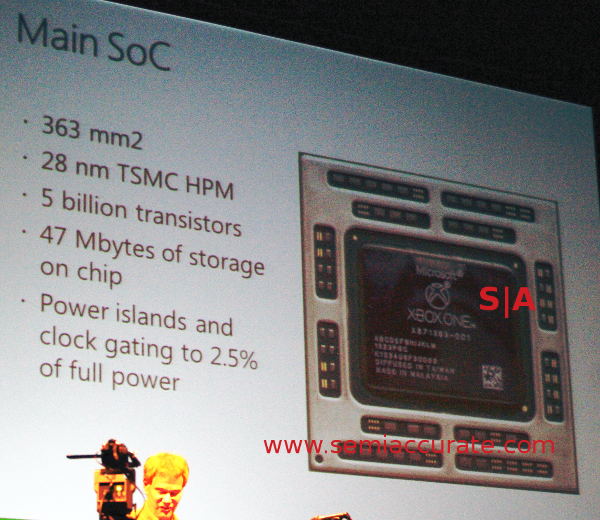
XBox One system diagram
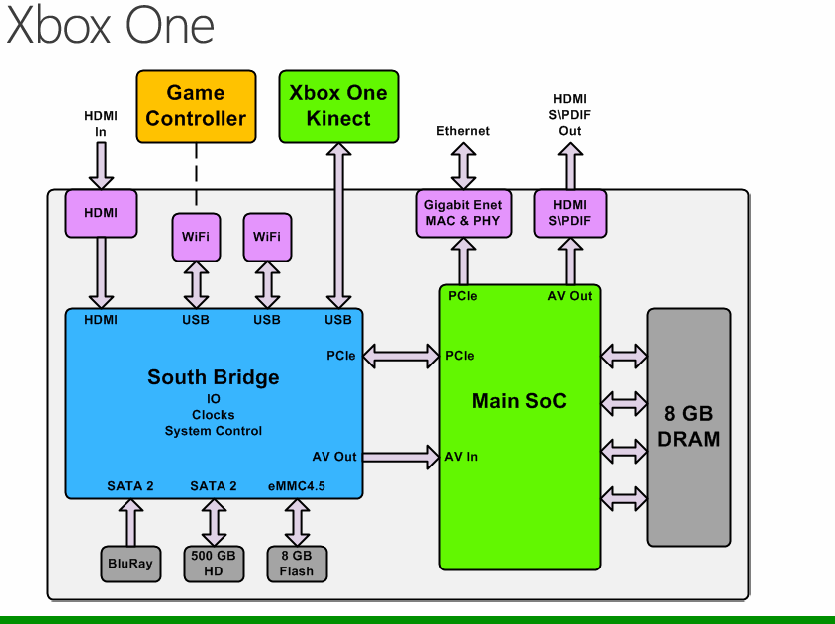
XBox One CPU diagram
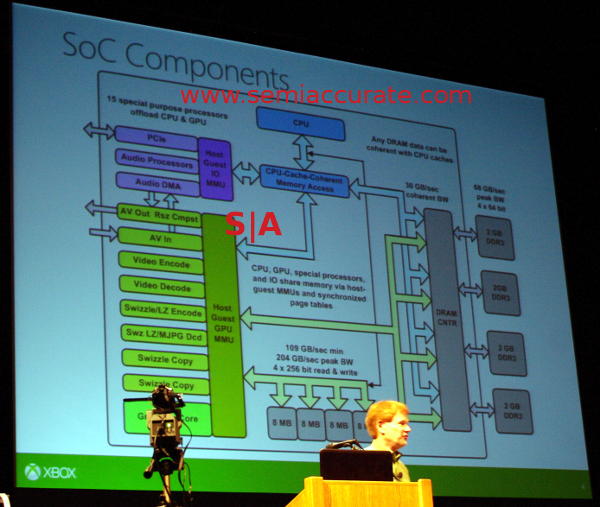
XBox One GPU diagram
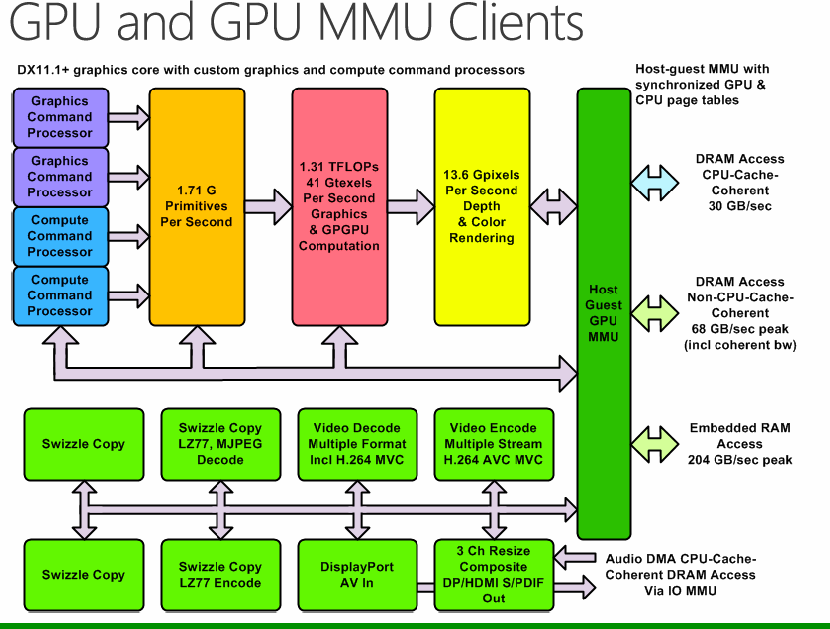
XBox One audio diagram
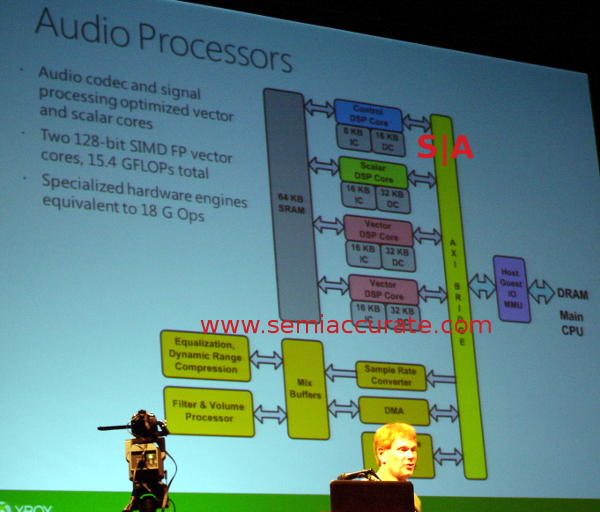
Kinect challenges
Each Xbox One will contain a Kinect depth camera, designed by Microsoft. (The camera used in the Xbox 360 was designed by PrimeSense, an Israeli developer)
Patrick O’ Connor, another system designer for Microsoft, explained that the chip can resolve players less than 1 meter away, and players at more than 2 meters away, with a 70-degree field of view. Microsoft also has to take into account a whole range of environments—from players that like to play games in the dark to broad daylight.
The Kinect on the Xbox One actually “illuminates” the room with its own modulated light. What the camera’s 512 x 424 sensor “sees” is the reflected light, which will be out of phase depending on the way it reflects from objects. The Xbox One then adds or subtracts their values to weed out the ambient light, determine the player’s location and motion, and what is the “active” image. Each Xbox One can distinguish up to six different players, O’Connor said, but exactly “who” is playing at any one time takes some figuring.

What the Xbox One can do, however, is determine, on a per-pixel basis, how best to “see” the object. Since the camera can’t actually lengthen its exposure or widen its aperture, it needs to use different shutter times, before picking the best one. Combining the Kinect’s own illumination with intelligent “reading” of the image eliminates common problems, such as sidelighting that can confuse the camera, O’Connor said.
Source: SemiAccurate.com & PC World
http://team-xecuter.com/xbox-one-details-in-pictures/
Thread Information
Users Browsing this Thread
There are currently 1 users browsing this thread. (0 members and 1 guests)
Similar Threads
-
Microsoft's Courier 'digital journal': exclusive pictures and details
By allaboutsymbian in forum Off Topic ForumReplies: 0Last Post: March 5th, 2010, 16:05 -
Notion Ink Adam gets detailed, pictured in its latest form
By allaboutsymbian in forum Off Topic ForumReplies: 0Last Post: February 14th, 2010, 23:05 -
More Hands-on Details From Xbox 360's Game Room [Ces10]
By indiegames in forum Off Topic ForumReplies: 0Last Post: January 8th, 2010, 04:20 -
PSP Slim Details Revealed With Pictures And Video
By gamefreak199101 in forum The Submit News ForumReplies: 0Last Post: August 29th, 2007, 23:57 -
Picture for the Xbox 360 fans wanting MGS4 on their console
By JKKDARK in forum Off Topic ForumReplies: 9Last Post: July 18th, 2007, 20:36




 Reply With Quote
Reply With Quote

Bookmarks